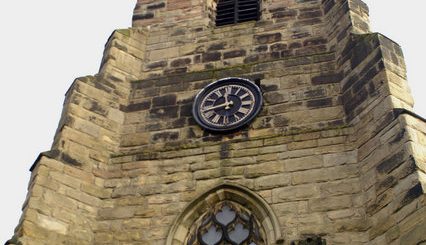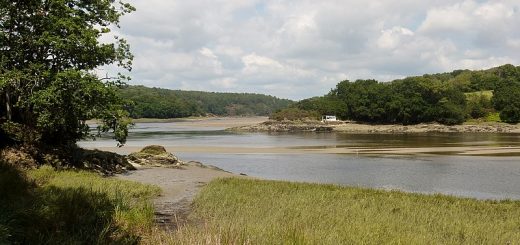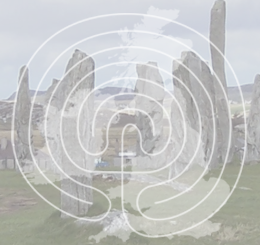Uffington White Horse and Dragon Hill
The White Horse of Uffington is one of the most impressive sites close to the ancient Ridgeway path, which traverses the steep chalk downs brooding over the Vale of the White Horse. Other sites include Dragon Hill, The Manger and Uffington Castle, which have been the subject of legend and folklore for over a thousand years.
The White Horse
 The White Horse of Uffington, with its elegant lines of white chalk bedrock, is thought to be the oldest hill figure in Britain. The image is a stylised representation of a horse (some would say dragon) some 374 feet in length, and is thought to date back as far as 1000BC in the late Bronze Age. Similar images have been found depicted on coins from that period, and it is thought that the figure represents a horse goddess connected with the local Belgae tribe. The goddess is generally believed to be one form of Epona, worshiped throughout the Celtic world.
The White Horse of Uffington, with its elegant lines of white chalk bedrock, is thought to be the oldest hill figure in Britain. The image is a stylised representation of a horse (some would say dragon) some 374 feet in length, and is thought to date back as far as 1000BC in the late Bronze Age. Similar images have been found depicted on coins from that period, and it is thought that the figure represents a horse goddess connected with the local Belgae tribe. The goddess is generally believed to be one form of Epona, worshiped throughout the Celtic world.
 The horse was ritually scoured every seven years under the jurisdiction of the local Lord, who had to fund the event. The festival – for that is what it became – could last for over three days and consisted of fun and games, traditional cheese rolling, wrestling and other pastimes. The focus of the games was in the enclosed earthen banks of Uffington Castle an Iron Age hill fort, which the White Horse seems to be galloping to when viewed from the air. The cheese rolling was held on the steep sided valley known as The Manger, the place where the horse was said to feed on moonlit nights. The festival, which may have had ancient origins, lapsed about a hundred years ago, and it is fortunate that the White Horse did not become completely overgrown. The horse is now cleaned by members of English Heritage, who are responsible for the site.
The horse was ritually scoured every seven years under the jurisdiction of the local Lord, who had to fund the event. The festival – for that is what it became – could last for over three days and consisted of fun and games, traditional cheese rolling, wrestling and other pastimes. The focus of the games was in the enclosed earthen banks of Uffington Castle an Iron Age hill fort, which the White Horse seems to be galloping to when viewed from the air. The cheese rolling was held on the steep sided valley known as The Manger, the place where the horse was said to feed on moonlit nights. The festival, which may have had ancient origins, lapsed about a hundred years ago, and it is fortunate that the White Horse did not become completely overgrown. The horse is now cleaned by members of English Heritage, who are responsible for the site.
Traditionally the horse is attributed to a number of famous figures, one of these is King Alfred, who is said to have had it constructed to commemorate his victory over the Danes in 871. The horse is also said to been cut by Hengist, the leader of the Anglo Saxon horde in the 5th century AD. Another piece of folklore suggests that the figure is actually a representation of the dragon killed by St George, an event thought to have taken place on nearby Dragon Hill.
Dragon Hill
 Dragon Hill is a low flat-topped mound situated in the valley below the White Horse. In legend it is the place where St George slew the dragon, its blood spilling on the hilltop and leaving forever a bare white patch where no grass can grow. Some suggest that the horse is a representation of St George’s steed or even of the slain dragon itself.
Dragon Hill is a low flat-topped mound situated in the valley below the White Horse. In legend it is the place where St George slew the dragon, its blood spilling on the hilltop and leaving forever a bare white patch where no grass can grow. Some suggest that the horse is a representation of St George’s steed or even of the slain dragon itself.
Uffington Castle
The castle is an impressive Iron Age hill fort, once protected by timber walls on top of the surviving banks and ditches, and faced with sarcen stones. It is likely that the tribe who created the White Horse once lived within this hill fort. The entrance to the hill fort was via the Northwest, protected by an earthen passageway that would have been further protected by wood. The castle was excavated in 1850 when evidence of the wooden structure was found, along with an Iron Age coin of the Dobunni tribe.
Some researchers believe that the castle marks the site of the battle of Badon, Arthur’s great victory over the Saxons. This is probably due to the important strategic position of the castle close to the Ridgeway. There is little evidence to suggest this is the case.
The Manger
 The manger is a strangely shaped valley, which is thought to have been formed by the melting of ice in the last Ice Age. Cheese rolling was held down the side of the valley during ‘The Scouring of the White Horse’ every seven years. Folklore suggests that the manger is the supernatural feeding place for the White Horse, which would travel from its vantage point on the crest of the hill on moonlit nights.
The manger is a strangely shaped valley, which is thought to have been formed by the melting of ice in the last Ice Age. Cheese rolling was held down the side of the valley during ‘The Scouring of the White Horse’ every seven years. Folklore suggests that the manger is the supernatural feeding place for the White Horse, which would travel from its vantage point on the crest of the hill on moonlit nights.
Directions: A minor road off the B4507, opposite the turn off to Uffington, leads to a car park, from which the sites can be explored.




Uffington Castle
Most beautiful peaceful site – great way to spend a day, the views are spectacular.
Satellite Image
I agree with you there. I hope that those who haven’t visited Uffington yet can get a idea of the layout using the Satallite view on the map above. It is certainly worth a visit.
Re: Uffington White Horse and Dragon Hill
One of my most favourite places in the country, in the summer skylarks sing and the views are magical. There’s also a lovely walk along the Ridgeway to Wayland’s Smithy.
Though the Horse can also appear and disappear on misty days!!
Re: Uffington White Horse and Dragon Hill
We visited this site a couple of years ago, I was 8 months pregnant and it was the only hill I walked during late pregnancy. It was fantastic to see the white horse, though when we went to see the castle site there was nothing but a circle and a sign telling you about the castle, I would have loved to see a ruin at least lol. Though it was a great way to spend an afternoon and the white horse is just fab..
Re: Uffington White Horse and Dragon Hill
I live 5 miles away , a beautiful place . Alsothere is an ancient burial ground there called Wayland Smithy